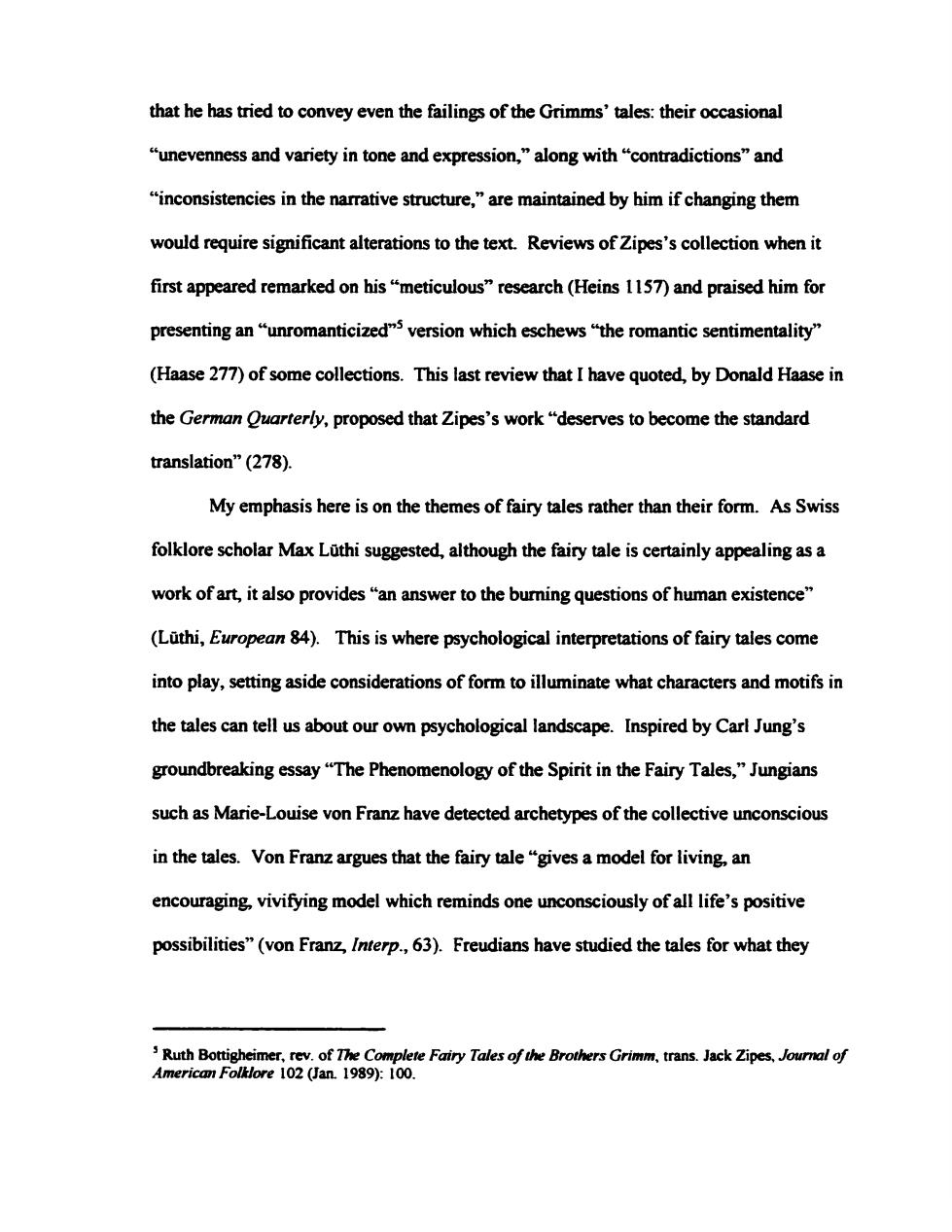
that he has tried to convey even the failings of the Grimms'tales:their occasional “unevenness and variety in tone and expression,”along with“contradictions”and "inconsistencies in the narrative structure,"are maintained by him if changing them would require significant alterations to the text.Reviews of Zipes's collection when it first appeared remarked on his"meticulous"research(Heins 1157)and praised him for presenting an“unromanticized”5 version which eschews“the romantic sentimentality” (Haase 277)of some collections.This last review that I have quoted,by Donald Haase in the German Quarterly,proposed that Zipes's work"deserves to become the standard translation”(278) My emphasis here is on the themes of fairy tales rather than their form.As Swiss folklore scholar Max Luthi suggested,although the fairy tale is certainly appealing as a work of art,it also provides"an answer to the buring questions of human existence" (Luthi,European 84).This is where psychological interpretations of fairy tales come into play,setting aside considerations of form to illuminate what characters and motifs in the tales can tell us about our own psychological landscape.Inspired by Carl Jung's groundbreaking essay"The Phenomenology of the Spirit in the Fairy Tales,"Jungians such as Marie-Louise von Franz have detected archetypes of the collective unconscious in the tales.Von Franz argues that the fairy tale"gives a model for living,an encouraging,vivifying model which reminds one unconsciously of all life's positive possibilities"(von Franz,Interp.,63).Freudians have studied the tales for what they Ruth Bottigheimer,rev.of The Complete Fairy Tales of the Brothers Grimm,trans.Jack Zipes,Journal of American Folklore 102 (Jan.1989):100
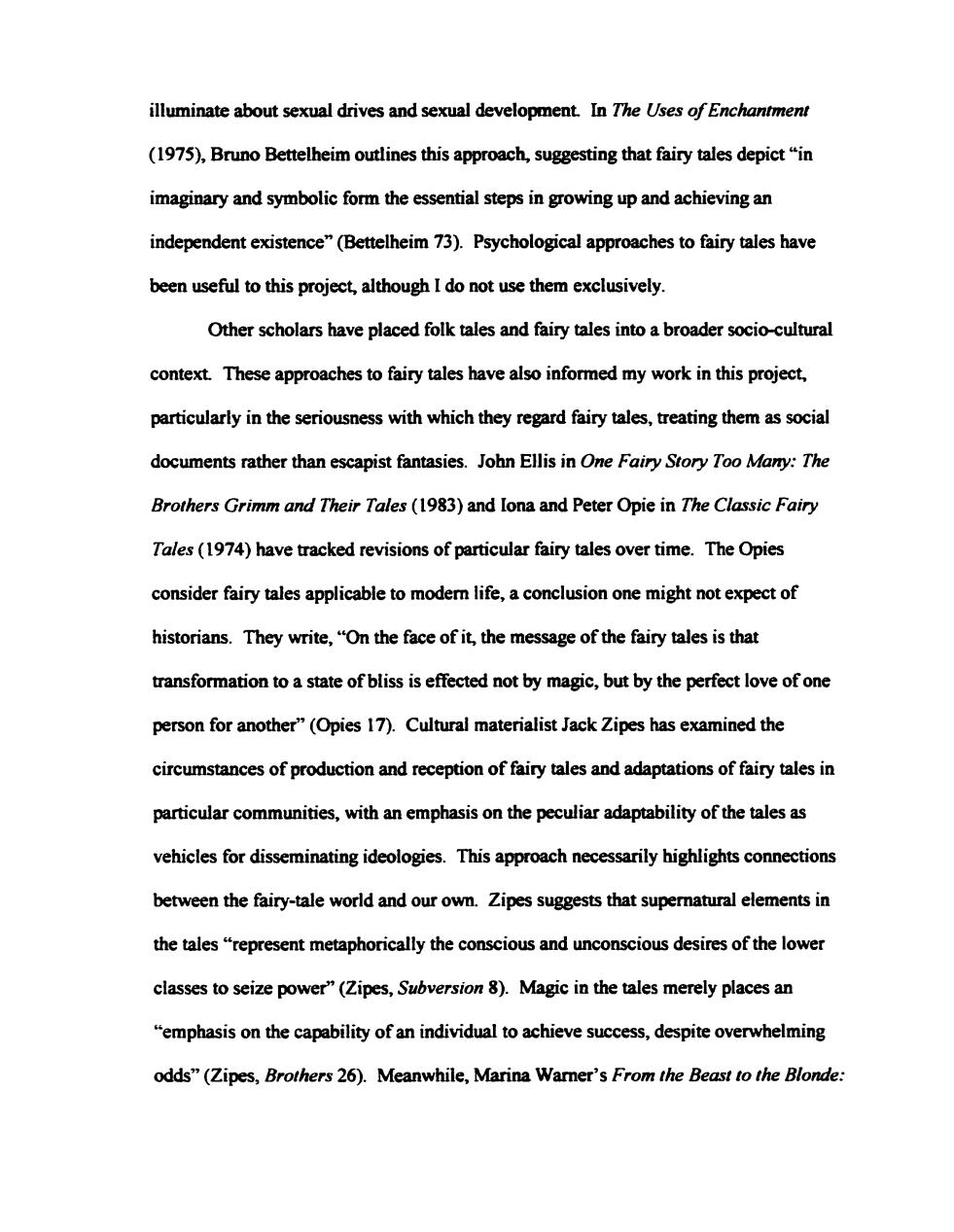
illuminate about sexual drives and sexual development.In The Uses of Enchantment (1975),Bruno Bettelheim outlines this approach,suggesting that fairy tales depict"in imaginary and symbolic form the essential steps in growing up and achieving an independent existence"(Bettelheim 73).Psychological approaches to fairy tales have been useful to this project,although I do not use them exclusively. Other scholars have placed folk tales and fairy tales into a broader socio-cultural context.These approaches to fairy tales have also informed my work in this project, particularly in the seriousness with which they regard fairy tales,treating them as social documents rather than escapist fantasies.John Ellis in One Fairy Story Too Mary:The Brothers Grimm and Their Tales(1983)and Iona and Peter Opie in The Classic Fairy Tales(1974)have tracked revisions of particular fairy tales over time.The Opies consider fairy tales applicable to modern life,a conclusion one might not expect of historians.They write,"On the face of it,the message of the fairy tales is that transformation to a state of bliss is effected not by magic,but by the perfect love of one person for another"(Opies 17).Cultural materialist Jack Zipes has examined the circumstances of production and reception of fairy tales and adaptations of fairy tales in particular communities,with an emphasis on the peculiar adaptability of the tales as vehicles for disseminating ideologies.This approach necessarily highlights connections between the fairy-tale world and our own.Zipes suggests that supernatural elements in the tales "represent metaphorically the conscious and unconscious desires of the lower classes to seize power"(Zipes,Subversion 8).Magic in the tales merely places an "emphasis on the capability of an individual to achieve success,despite overwhelming odds"(Zipes,Brothers 26).Meanwhile,Marina Warer's From the Beast to the Blonde:
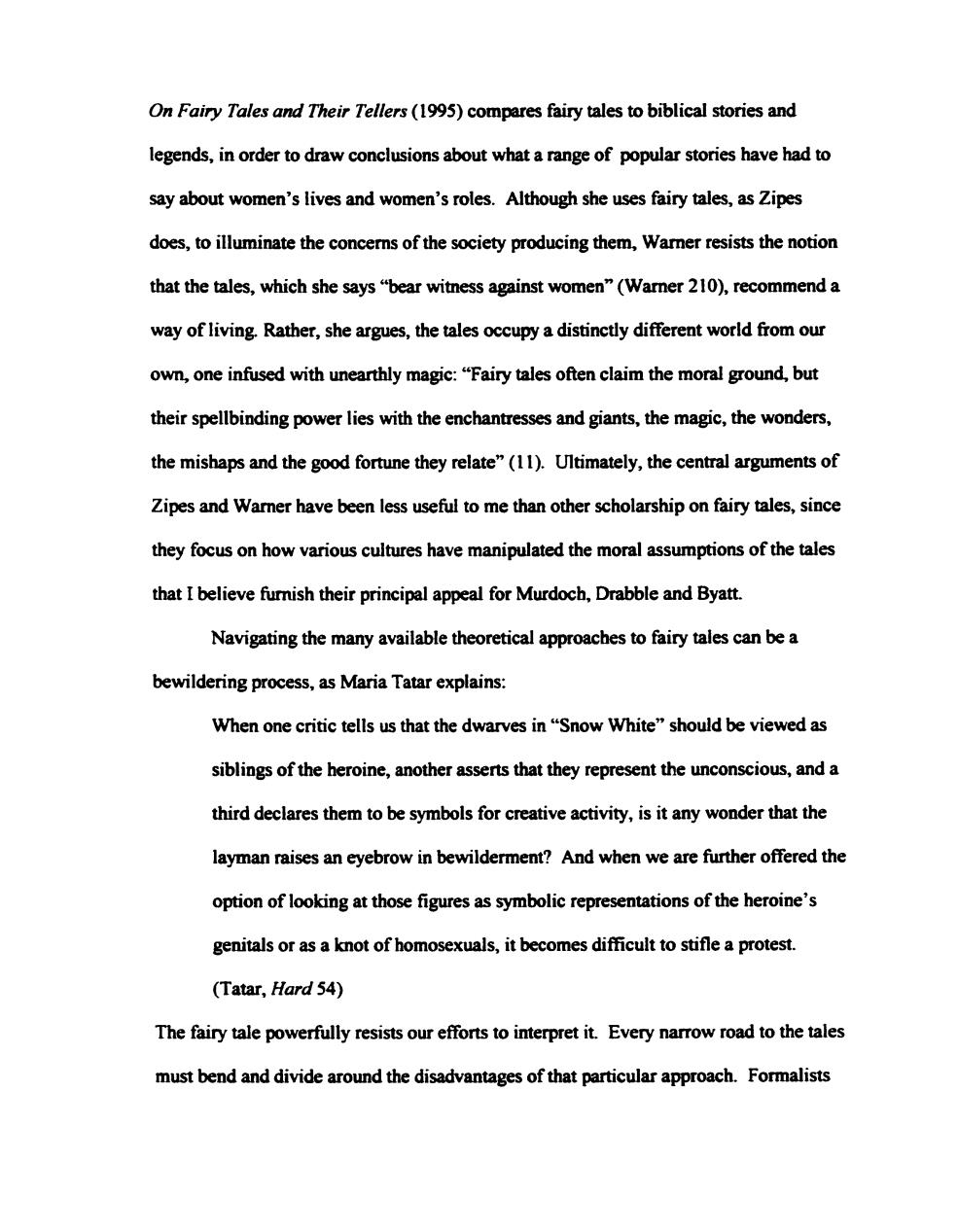
On Fairy Tales and Their Tellers(1995)compares fairy tales to biblical stories and legends,in order to draw conclusions about what a range of popular stories have had to say about women's lives and women's roles.Although she uses fairy tales,as Zipes does,to illuminate the concerns of the society producing them,Warner resists the notion that the tales,which she says "bear witness against women"(Warner 210),recommend a way of living.Rather,she argues,the tales occupy a distinctly different world from our own,one infused with unearthly magic:"Fairy tales often claim the moral ground,but their spellbinding power lies with the enchantresses and giants,the magic,the wonders, the mishaps and the good fortune they relate"(11).Ultimately,the central arguments of Zipes and Warner have been less useful to me than other scholarship on fairy tales,since they focus on how various cultures have manipulated the moral assumptions of the tales that I believe furnish their principal appeal for Murdoch,Drabble and Byatt. Navigating the many available theoretical approaches to fairy tales can be a bewildering process,as Maria Tatar explains: When one critic tells us that the dwarves in"Snow White"should be viewed as siblings of the heroine,another asserts that they represent the unconscious,and a third declares them to be symbols for creative activity,is it any wonder that the layman raises an eyebrow in bewilderment?And when we are further offered the option of looking at those figures as symbolic representations of the heroine's genitals or as a knot of homosexuals,it becomes difficult to stifle a protest. (Tatar,Hard 54) The fairy tale powerfully resists our efforts to interpret it.Every narrow road to the tales must bend and divide around the disadvantages of that particular approach.Formalists
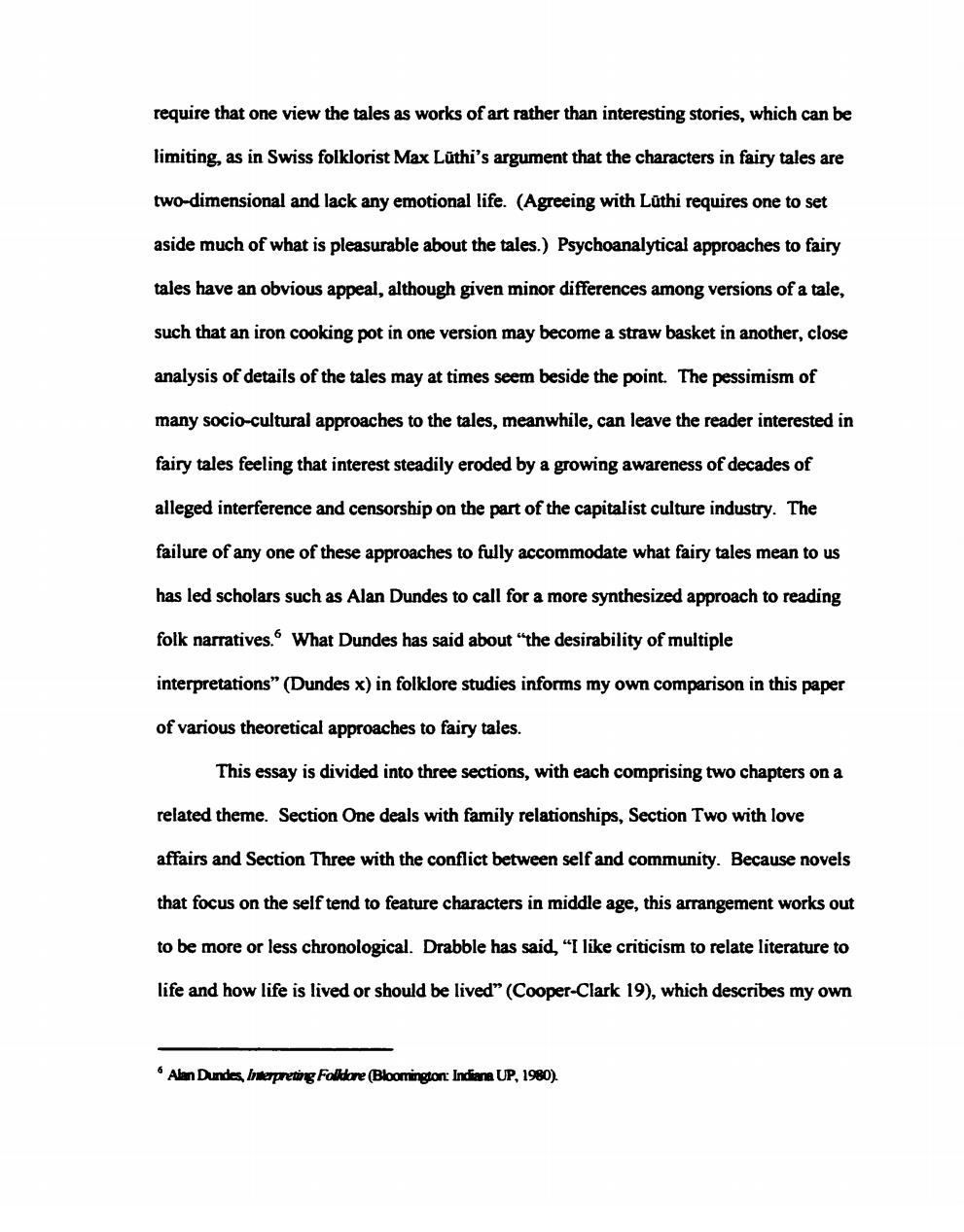
require that one view the tales as works of art rather than interesting stories,which can be limiting,as in Swiss folklorist Max Luthi's argument that the characters in fairy tales are two-dimensional and lack any emotional life.(Agreeing with Luthi requires one to set aside much of what is pleasurable about the tales.)Psychoanalytical approaches to fairy tales have an obvious appeal,although given minor differences among versions of a tale, such that an iron cooking pot in one version may become a straw basket in another,close analysis of details of the tales may at times seem beside the point.The pessimism of many socio-cultural approaches to the tales,meanwhile,can leave the reader interested in fairy tales feeling that interest steadily eroded by a growing awareness of decades of alleged interference and censorship on the part of the capitalist culture industry.The failure of any one of these approaches to fully accommodate what fairy tales mean to us has led scholars such as Alan Dundes to call for a more synthesized approach to reading folk narratives.s What Dundes has said about"the desirability of multiple interpretations"(Dundes x)in folklore studies informs my own comparison in this paper of various theoretical approaches to fairy tales. This essay is divided into three sections,with each comprising two chapters on a related theme.Section One deals with family relationships,Section Two with love affairs and Section Three with the conflict between self and community.Because novels that focus on the self tend to feature characters in middle age,this arrangement works out to be more or less chronological.Drabble has said,"I like criticism to relate literature to life and how life is lived or should be lived"(Cooper-Clark 19),which describes my own Alan DundesInerpreting Folldore (Bloomington:Indiana UP,1980)
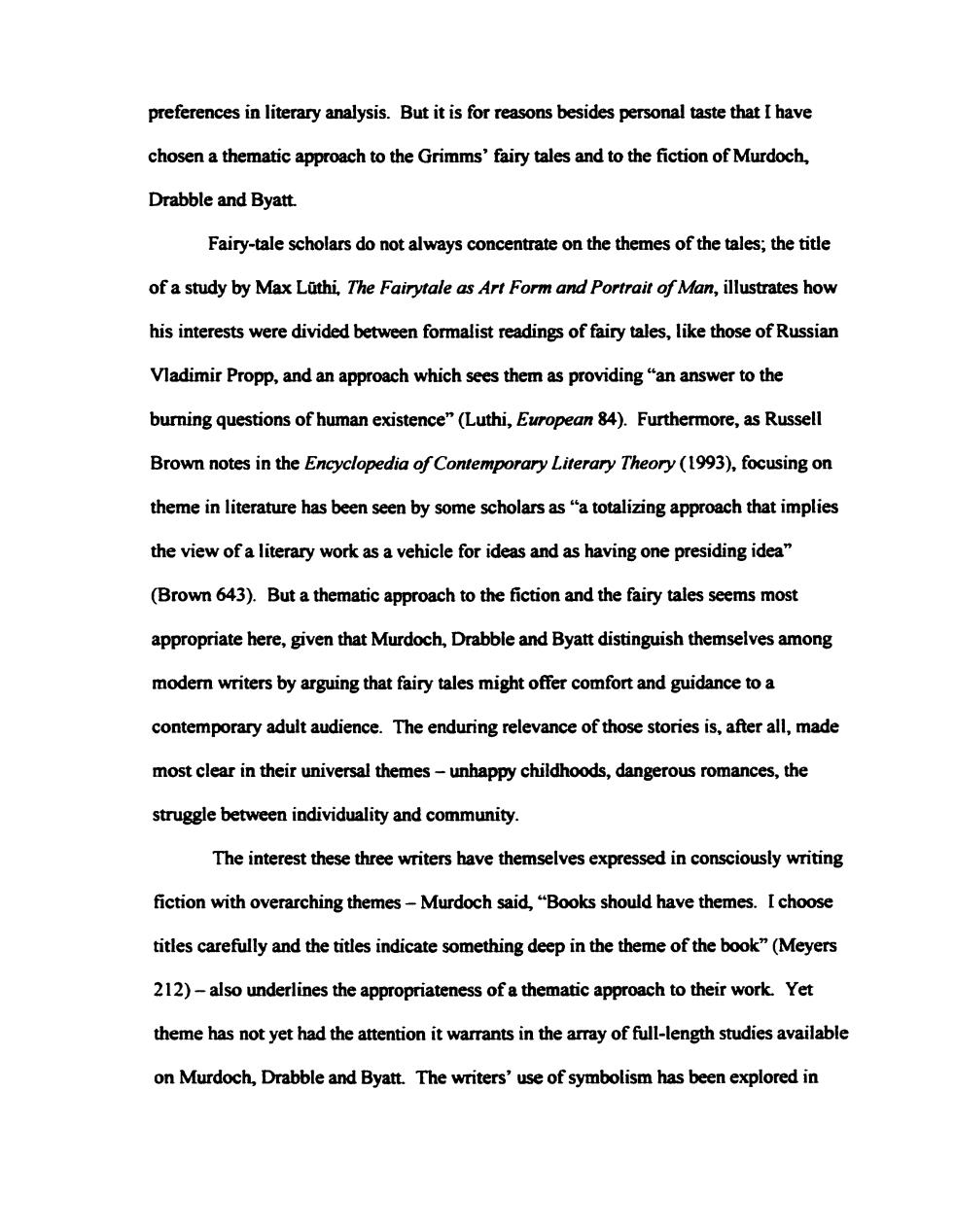
preferences in literary analysis.But it is for reasons besides personal taste that I have chosen a thematic approach to the Grimms'fairy tales and to the fiction of Murdoch, Drabble and Byatt. Fairy-tale scholars do not always concentrate on the themes of the tales;the title of a study by Max Luthi,The Fairytale as Art Form and Portrait of Man,illustrates how his interests were divided between formalist readings of fairy tales,like those of Russian Vladimir Propp,and an approach which sees them as providing"an answer to the burning questions of human existence"(Luthi,European 84).Furthermore,as Russell Brown notes in the Encyclopedia of Contemporary Literary Theory (1993),focusing on theme in literature has been seen by some scholars as"a totalizing approach that implies the view of a literary work as a vehicle for ideas and as having one presiding idea" (Brown 643).But a thematic approach to the fiction and the fairy tales seems most appropriate here,given that Murdoch,Drabble and Byatt distinguish themselves among modern writers by arguing that fairy tales might offer comfort and guidance to a contemporary adult audience.The enduring relevance of those stories is,after all,made most clear in their universal themes-unhappy childhoods,dangerous romances,the struggle between individuality and community The interest these three writers have themselves expressed in consciously writing fiction with overarching themes-Murdoch said,"Books should have themes.I choose titles carefully and the titles indicate something deep in the theme of the book"(Meyers 212)-also underlines the appropriateness of a thematic approach to their work.Yet theme has not yet had the attention it warrants in the array of full-length studies available on Murdoch,Drabble and Byatt.The writers'use of symbolism has been explored in